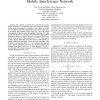Free Online Productivity Tools
i2Speak
i2Symbol
i2OCR
iTex2Img
iWeb2Print
iWeb2Shot
i2Type
iPdf2Split
iPdf2Merge
i2Bopomofo
i2Arabic
i2Style
i2Image
i2PDF
iLatex2Rtf
Sci2ools
ISCC
2003
IEEE
2003
IEEE
Throughput Achievable with No Relaying in a Mobile Interference Network
— We consider a network of n sender/receiver pairs, placed randomly in a region of unit area. Network capacity, or maximum throughput, is defined as the highest rate that can be achieved by each sender/receiver pair over a long time. It is known that without using relays (i.e., via only direct communication), the maximum throughput is less than O(1), that is, it strictly decays as n increases. The network capacity without relaying for static or mobile networks is not known. However, a known lower bound on this capacity is O(log(n) n ). Our goal is to find a higher achievable rate. We show, by demonstrating a simple coding and scheduling scheme that uses mobility , that O(log(n) n1−β ) is achievable, where β > 0 is a constant that depends on the power attenuation factor in the wireless medium. For example, when power decays as d−4 with distance d, O(log(n) n.25 ) is achievable. We assume channels to be AWGN interference channels throughout this work.
Related Content
| Added | 04 Jul 2010 |
| Updated | 04 Jul 2010 |
| Type | Conference |
| Year | 2003 |
| Where | ISCC |
| Authors | Elif Uysal-Biyikoglu, Abtin Keshavarzian |
Comments (0)

